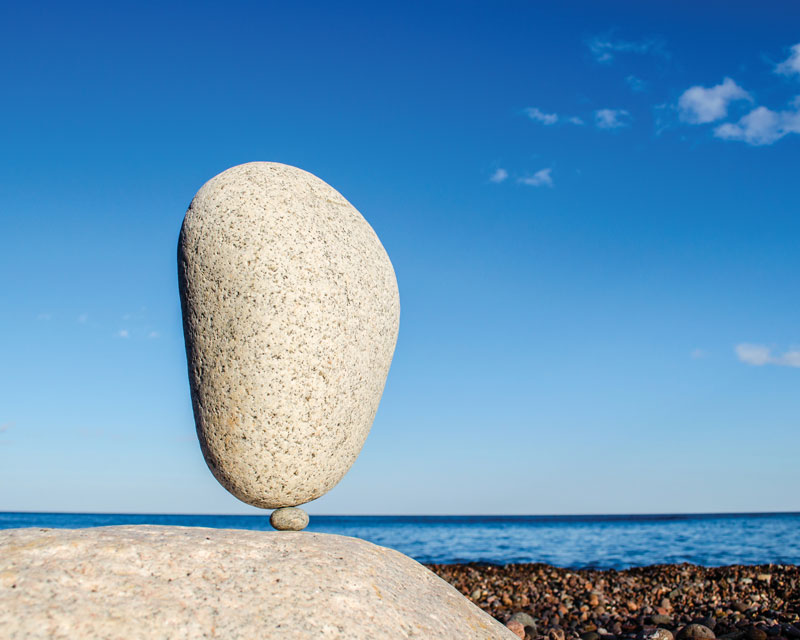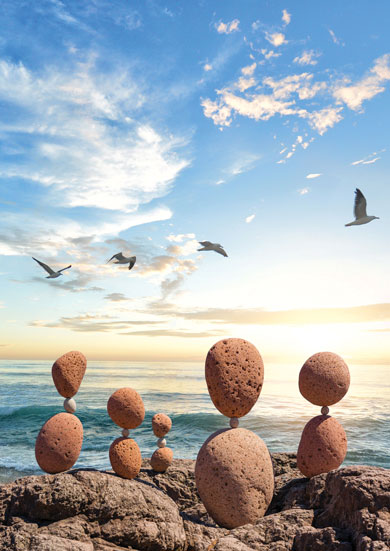
The Zen Spirit of Rock Balancing
How artist Peter Juhl creates magical works of art
- Text by J.H. White
- Photos Courtesy of Peter Juhl
“If you push too hard or you want something too badly, you can sabotage yourself by your attitude. Caring, but not caring too much, is the key.”
—Peter Juhl
When I saw Peter Juhl’s rock balancing feats, I was amazed by the way the rocks seemed to float into the air. I first thought he must be using an extraordinarily strong glue to keep them perched on top of each other with just tiny points of contact.
I quickly discovered that Juhl doesn’t use glue, magnets, or other artificial supports to balance them. He simply uses gravity and counterbalance. This makes Juhl’s rock balancing seem almost supernormal, as if the rocks were dancing together in stillness for one eternal moment in time.
“It’s a really strange art form because most people have never heard of it,” he says.

During our conversation, Juhl demystified the art of rock balancing and explained how it has rebalanced his own life.
Intuition and dexterity
In his youth, Juhl vacationed regularly at Lake Superior, Minnesota. One day, twenty five years ago, he was bored with throwing and skipping rocks on the beach. He had a simple idea.
He sat on the bedrock and used the bubbles and cracks in its surface to lodge the corner of a rock to help it stand upright.
“When it stood up, I was amazed. Later, I learned that I could develop this as an art form, creating sculptures that are aesthetically beautiful and pleasing,” Juhl says.
The art of rock balancing is not just visually rewarding; it has also helped him to become more mindful.
“I’m holding the rock where it needs to be and just a random little shake of my hand can actually position it. When you know it’s there, you can let go,” he says.
Other than an initial vision of what the sculpture might become, Juhl says he doesn’t consciously think while working. He’s just extremely present.
When teaching workshops, Juhl notices that his students have a similar experience.
“They get to this state where their fingers suddenly know what to do,” he says.
“Your mind goes blank and you’re just feeling that rock. You’re even feeling how the rock is leaning and the tiny vibrations as the rock scrapes against the next one.”
Juhl says this is analogous to riding a bike. Your mind doesn’t sit on the bicycle, consciously computing all the physical movements needed to stay balanced and upright. “Something takes over and it happens by itself,” he says.

The secrets of rock balancing
As he advances in his art form, Juhl is learning trade secrets and understanding principles that guide him in his art and life.
Early on, he discovered that there needs to be an imperfection in one of the rocks—a divot, depression, crack, or bubble—to cradle another rock. It could be as small as an eighth of an inch, but it must be there.
“It’s an interesting irony—the imperfections in the rocks are what allow this beautiful structure to be made,” he says.
When he was first starting with his craft, Juhl felt pressure to plan his artistic trips well and ensure good weather and supplies. He’d arrive at the beach early in the morning, it’d be cold, and he’d think, “I need to get something done here before I get too tired or before it gets dark or cloudy.”
“That’s the opposite of the frame of mind you need when you want to do this. You need to have an open mind and a clear head and just be willing to play with the rocks until something happens,” Juhl says.
“I want to do good work. But you don’t want to take yourself too seriously and suddenly become a robot that just has to create.”
The balanced state of mind he needed for the rock formations also helped Juhl in his day job as an IT administrator for a Fortune 500 company.
“I was a hard driver at work and always wanted to advance. Later in my career, I realized, ‘Hey, just enjoy this. Be creative. Things will fall into place.’ And they did.”
After a long, successful IT career, Juhl retired last year.
“If you push too hard or you want something too badly, you can sabotage yourself by your attitude,” he says. “Caring, but not caring too much, is the key.”
Zen beauty in rock balancing
Juhl likens rock balancing to Tibetan Buddhist monks’ tradition of creating sand mandalas. Each mandala involves a long, laborious process, yet the monks sweep it up as soon as it’s done.
“What’s important is that they created it. It’s not important to own or keep it. I feel the same way about these rock sculptures,” Juhl says.
He sometimes sees his students create a beautiful sculpture that falls down soon after it’s ready. The students sometimes become angry and disappointed to see their work disappear so quickly.
But longevity is not the goal of this art form, he says. “I’ve had sculptures that literally fell down five seconds after I created them. Stone balancing is really about the process of creation.”
After years of practicing this meditative art form, his sense of beauty has evolved. Large, complicated, tall stacks of rocks don’t interest him as much. The paradox is that most simple sculptures aren’t easy to build.
“You can’t come to that simple sculpture without having quite a bit of technical skill,” he says. “But it’s not technical skill just for the sake of technical skill. It’s technical skill used to contribute to something that’s consciously meant to be aesthetic.”

A healing art
When Juhl teaches a workshop, he’s not just passing on his skills and expertise. He’s sharing a transformative art form.
A few years ago, Juhl was giving a master class. One of his students helped him to pack up the rocks afterwards. The student told Juhl that he had struggled with ADD (attention deficit disorder) his entire life, which had also affected him professionally.
He said, “Rock balancing has just been an incredible aid. It’s helped me learn to focus, slow down my thoughts, and slow down my need to do things. It’s been a godsend to be able to just stop and balance rocks. I wanted to thank you for introducing me to this art form because it has helped my life.”
“That was one of the best affirmations of why I do this,” Juhl says.
Inspired for a Beautiful Life
Related Articles

Shen Yun Dancer Lives Her Beliefs
Behind the scenes with Shen Yun dancer, Teresa Du, where simplicity and traditional Chinese values foster teamwork.

Healing Travel
From meditation to holistic spas, enhance your well-being at these six wellness treatment destinations.

In the Nick of Time
Haute Couture Designers who came to the rescue of Miss World Canada, Anastasia Lin









